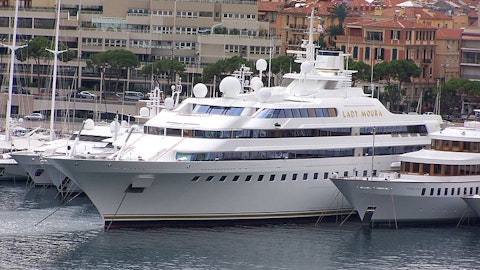MarineMax, Inc. (NYSE:HZO) Q4 2023 Earnings Call Transcript October 26, 2023
MarineMax, Inc. reports earnings inline with expectations. Reported EPS is $0.69 EPS, expectations were $0.69.
Operator: Good morning, and welcome to the MarineMax, Inc. Fiscal 2023 Fourth Quarter and Full Year Conference Call. Today’s call is being recorded. [Operator Instructions] At this time, I would like to turn the call over to Scott Solomon of the Company’s Investor Relations firm, Sharon Merrill. Please go ahead, sir.
Scott Solomon: Good morning, and thank you for joining us. Hosting today’s call are Brett McGill, MarineMax’s President and Chief Executive Officer; and Mike McLamb, the Company’s Chief Financial Officer. Brett will begin the call by discussing MarineMax’s operating highlights, Mike will review the financial results, and then, management will be happy to take your questions. The earnings release and supplemental presentation can be found at investor.marinemax.com. With that, I’ll turn the call over to Mike.

An aerial view of a boat sailing in the open sea at sunset. Editorial photo for a financial news article. 8k. –ar 16:9
Michael McLamb: Thank you, Scott. Good morning, everyone, and thank you for joining this call. I’d like to start by reminding you that certain of our comments are forward-looking statements as defined by the Private Securities Litigation Reform Act of 1995. Any forward-looking statements speak only as of today. These statements involve risks and uncertainties that could cause actual results to differ materially from expectations. These risks include, but are not limited to, the impact of seasonality and weather, global economic conditions and the level of consumer spending, the Company’s ability to capitalize on opportunities or grow its market share, and numerous other factors identified in our Form 10-K and other filings with the Securities and Exchange Commission.
Also on today’s call, we will make comments referring to non-GAAP financial measures. We believe that the inclusion of these financial measures helps investors gain a meaningful understanding of the changes in the Company’s core operating results. These metrics can also help investors who wish to make comparisons between MarineMax and other companies on both a GAAP and a non-GAAP basis. A reconciliation of non-GAAP financial measures to the most directly comparable GAAP measures is available in today’s earnings release. With that, let me turn the call over to Brett. Brett?
William McGill: Thank you, Mike. Good morning, everyone, and thank you for joining us. I want to begin by thanking the entire MarineMax team, whose outstanding customer service contributed to strong topline growth in fiscal 2023. As evidenced by our record fourth quarter and full-year revenue, demand for the boating lifestyle remains strong. From our 81 retail locations to our manufacturing facilities, marinas and superyacht operations worldwide, our team is focused on one mission: to provide the world’s best pleasure boating experience. Through strategic acquisitions, we are broadening our presence well beyond retail dealerships to higher-margin segments of the industry that encompasses all aspects of the boat ownership lifecycle and enables us to build deep customer relationships.
Today, Mike and I are speaking to you from the Ft. Lauderdale International Boat Show, where here representing all of our premium product line, as well as large displays for Fraser Yachts, Northrop & Johnson and IGY Marinas. We anticipate robust attendance and we are particularly excited about the demand we continue to see in the premium segment, one of the critical drivers of our long-term growth strategy. Turning to our fourth quarter performance, we saw continued momentum from our strategic marketing and customer engagement initiatives, which drove an 8% increase in same-store sales. New and used boat sales were up in dollars and units with the premium category again performing well. However, we also saw better strength in categories that were lagging earlier in the year like pontoons and towboats.
Solid revenue gains in our higher-margin businesses like service, and finance and insurance contributed to the same-store sales increase. IGY Marinas, which we acquired last October contributed meaningfully to our revenue growth for the quarter and full-year. From a cadence perspective, as we noted on our July call, the quarter started strong and generally stayed active through the entire quarter with a strong close to September. Although our full-year adjusted EPS and adjusted EBITDA were in line with our most recent guidance, there’s some additional work we need to do. We are looking specifically at SG&A expenses to evaluate more fully the latitude we have to reduce costs in areas that do not impact the customer experience. Clearly, inflation has affected operating costs.
But we believe cost synergies do exist, and we will work to offset some of that inflation going forward. Given rising inventory levels across the industry and a return to seasonality, we had anticipated some retail margin erosion in the quarter. However, we were pleased to see gross margins remain in the mid-30%. Plus, for the full-year, our gross margins are flat at about 35%. That speaks to our business’s increasing diversification and resilience across market cycles, as well as our strategy of adding higher-margin businesses. Sophisticated data and analytics are adding more precision to our marketing initiatives. For example, we are using intelligent customer and inventory tools to monitor demand in real-time. These tools enable us to drive marketing demand and inventory alignment.
Our expanded strategic marketing capabilities are clearly driving improved retail results and driving market share growth. We are also gaining momentum with New Wave Innovations. More and more marine dealerships are registering to use boatzon.com, our digital retailing marine platform. In much the same way, technology has streamlined the process of buying a car, Boatzon is simplifying the customer experience of purchasing a boat. While still in the start-up phase, we expect a bright future for Boatzon. Turning to other recent highlights. This month, Fraser Yachts completed the previously-announced, very strategic acquisition of Atalanta Golden Yachts or AGY. Based in Athens, AGY is one of Greece’s leading charter management company. The addition of AGY is consistent with our strategy of adding high-quality businesses that enhance our margin profile.
AGY complements and greatly expands our superyacht services business in Greece, a major charter destination and home to one of the largest superyacht fleet in the world. Our M&A pipeline remains active and we continue to evaluate potential opportunities that align with our strategic priorities. A number of investors have asked us about the near-term industry outlook in light of the current economic environment. From a macro perspective, we are approaching fiscal 2024 with appropriate caution, but are encouraged by how 2023 ended. Nonetheless, we realize much uncertainty faces the world. That said, we continue to focus on the areas within our control by reviewing expenses, deploying our capital wisely and capturing revenue synergies. As we look ahead to 2024, we are excited to build upon this foundation and deliver on our commitment to providing unparalleled boating and yachting experiences to a growing number of customers worldwide.
With that update, let me turn the call over to Mike for a financial recap. Mike?
Michael McLamb: Thank you, Brett. I also want to thank our team for their efforts, which produced a strong fourth quarter and a record revenue in fiscal 2023. In the quarter, we grew revenue 11% to $595 million, driven by an 8% increase in same-store sales. The same-store improvement was driven roughly 50-50 by units and average unit selling price growth. Consistent with our commentary all year, our premium brands continue to outshine any price point categories. However, as Brett noted, we did see additional strength this quarter from traditional seasonal boats like pontoons and towboats, two categories that lagged earlier in the year. Geographically, we saw positive trends in most markets, with particular strength in Florida and the Midwest.
Gross profit of $204 million was up $7 million from last year, while gross margin was down year-over-year to 34.3%. As expected, product margins moderated as inventory levels in the industry have increased. Generally, product margins approached pre-pandemic levels, while our consolidated margins remain in the mid-30s. As Brett said, the strength of our consolidated margins is a testament to our strategy of adding higher-margin businesses. SG&A expenses were up 16% to a $169 million, well over half the dollar increase was from the IGY, Midcoast, Boatzon and C&C acquisitions we completed this year. However, we did see increases from various categories such as health insurance, property insurance, inventory maintenance and marketing to name a few.
Clearly, some of the costs drove topline growth, but as Brett mentioned, we are exploring various opportunities to improve synergies internally, as well as areas for cost savings, while not impacting the experience of the customer. Interest expense increased by $14.8 million, reflecting rising interest rates, increased inventory and higher long-term debt associated with IGY. Given the increase in rates, floor plan interest was incrementally higher than we expected. On the bottom-line, we generated GAAP net income of more than $15 million or $0.67 per diluted share compared with net income of $38.4 million or $1.73 per diluted share last year. Our adjusted EBITDA for the quarter was $43 million compared with $68 million last year, primarily due to lower net income and higher floor plan interest expense, which accounted for nearly $8 million of the difference.
For the full-year, GAAP net income was $109 million or $4.87 per diluted share and we generated adjusted net income of $117 million or $5.21 per diluted share, in line with our guidance. Our full-year adjusted EBITDA was in line with guidance at $239 million compared with $310 million last year with floor plan interest expense accounting for roughly $25 million of the difference. Our balance sheet remains healthy as we ended the year with more than $200 million in cash. Inventories at year-end increased $813 million, which, as expected, was up sequentially from June. On a same-store basis, unit inventories are in the neighborhood of down a little over 30% compared with September 2019 levels. Looking at liabilities, our short-term borrowings, which is our floor plan financing, rose largely due to increased inventories and the timing of payments.
As expected, customer deposits declined sequentially from June to $82 million, reflecting our ability to better meet demand as inventory becomes available. Our liquidity position remains strong. At year-end debt-to-EBITDA net of cash was less than 1. We have additional liquidity in the form of unlevered inventory plus available lines of credit that totaled approximately $200 million. Turning to guidance. I will comment first on our thoughts regarding the industry unit trends for our fiscal year 2024. For many months of the upcoming year, the year-over-year unit trends are relatively easy comparisons in terms of the industry’s ability to post either unit growth or a minimal decline. Assuming no significant economic downturn, but also no major improvements, we believe the industry will be flattish to up slightly in our fiscal year.
We also believe that the premium end will continue to outperform price point segments. We expect the industry to be back in full seasonal mode for all of fiscal 2024. This means the December quarter will be by far the smallest quarter of the year, followed by seasonally stronger quarters through the selling season. We also expect inventory to modestly build seasonally as it has historically. Based on our industry unit expectations, we expect low-to-mid single-digit same-store sales growth in 2024. At the same time, we do expect product margins to moderate as we continue to reap the long-term benefits of the higher-margin strategy we have successfully executed. It’s also worth noting that in the December ’22 and March ’23 quarters, we had lower interest costs, driven by lower rates and lower inventory than we will have in the same quarters this fiscal year.
Factoring all this in, we expect our adjusted net income per share to be in the range of $4.50 to $5 per diluted share for fiscal 2024, with adjusted EBITDA to be in the range of $225 million to $250 million. Higher depreciation and stock-based compensation, as well as additional shares in the denominator adversely impacts EPS versus adjusted EBITDA. We are using an expected tax rate of approximately 27% and a share count of 23.1 million shares in our assumptions. Looking at current trends, October last year was aided by boats that pushed from September due to Hurricane Ian. This year, October currently looks to be flattish to that strong comparison as people continue to seek the boating lifestyle. With that, I’ll turn the call back over to Brett for closing comments.
Brett?
William McGill: Thanks, Mike. Despite a challenging market environment, we executed well in fiscal 2023, delivering record revenue and strong gross margins. While the retail boating industry continues to see a return to historical seasonality, our diversified revenue stream and our position in the premium segment of the retail market creates a sustainable competitive advantage for MarineMax. Our strategic initiatives over the past several years continues to improve our long-term margin profile and generate new growth opportunities. MarineMax is a diversified global marine company providing an international customer base with the products, services and experiences to enrich their journey on the water. We remain committed to maintaining MarineMax’s financial strength and building long-term shareholder value by pursuing opportunities to drive profitable growth. And with that, operator, let’s open up the call for questions.
See also Top 20 Animal Health Companies in the World and 12 Most Efficient Electric Vehicles in the World.
Q&A Session
Follow Marinemax Inc (NYSE:HZO)
Follow Marinemax Inc (NYSE:HZO)
Operator: [Operator Instructions] Our first question comes from James Hardiman with Citi. Please go ahead.
James Hardiman: Hi, good morning. Thanks for taking my call. So Mike, you talked about the comparison. Maybe walk us through — it seems like maybe the December quarter should see maybe the best growth of the year. Maybe it’s easiest to predict, because it’s most current. But that full-year low-to-mid single-digit same-store sales, how do you think about that progression over the course of the year?
Michael McLamb: Yes. Great question, James. The — yes, for sure, from an industry perspective, the December quarter does appear to be the easiest comparison with the unit declines on a year-over-year basis. But even if you go all the way into January, February, March, April and even into May, the comparisons are relatively easy. And then they are mixed when you go through the rest of our fiscal year June, July, August and September. So, as I said on the call, it sure seems like absent a recession, many of those months have the ability to those positive unit gains. And historically, if the industry has unit growth, we traditionally outperform the industry. And then you get a migration of average unit selling price, which is kind of the basis of our same-store sales growth for 2024.
James Hardiman: Got it. That’s helpful. And then, on the inventory question, I think you touched on a little bit of it in the prepared remarks. But can you just bridge last year’s inventory number and this year year’s inventory number, specifically as we think about sort of acquired inventory, but then also units versus dollars? And as we think about how you’re thinking about ordering patterns and inventory going forward, are we at a place where you would generally think about a unit in and a unit out, right, wholesale equaling retail or do you anticipate lowering inventories on a like-for-like basis or building inventories on a like-for-like basis?
Michael McLamb: So, let me try to take all those questions, if I can remember. On a year-over-year basis, there really isn’t a whole lot of acquiring growth in terms of acquisitions. The C&C acquisition was a smaller one, so there is some from that. A little bit, I guess, from in terms of the balance sheet inventory from IGY that has fuel and stuff like that, but the bulk of the growth is just building of inventories from last year, which was a relatively low level skewed by dollar growth, quite frankly. So the — as I said, the units on a same-store basis are still down 30% from 2019 levels. It’s probably not surprising that we have some categories and some areas that are heavier inventory than we necessarily need, you’ve seen what’s gone on in the industry with pontoons and tows — towboats.
We’re working very closely with all of our manufacturers in those categories. And they’re all very receptive to the dialog about products that we need and how we’re trying to get inventories in line. But likewise, there’s categories over still pretty far below and where we need product in some of the real premium larger center console outboard and even some of the larger product that we sell. So it’s an interesting time right now. The industry is rebuilding to some level of healthy inventory that all the dealers are trying to stay at a very healthy inventory. Actually, I think all the manufacturers are recognizing that it’s important to stay at that level too. So, well, we’ll probably have some seasonal build. I think we’ll be in a pretty good place overall from a unit inventory perspective as we go through 2024.
James Hardiman: Got it. So your base case is it’s effectively wholesale equal to retail from a yield perspective over the next year?
Michael McLamb: I actually think in some categories it is probably not the case, where we need product. But certainly and not to speak out of both sides, but out, there is other categories where, yes, we need to retail more than we’re bringing in time periods in some of the categories that have been softer during the year.
James Hardiman: Got it. That’s helpful. Appreciate it.
Michael McLamb: Thanks, James.
Operator: Thank you. Our next question comes from Drew Crum with Stifel. Please go ahead.
Drew Crum: Okay. Thanks. Hi, guys. Good morning.
Michael McLamb: Good morning, Drew.
Drew Crum: So on your fiscal ’24 guidance, just at a high level, can you comment on what type of macroeconomic outlook you’re assuming? In other words, does your forecast embed a recession scenario or any other incremental macro headwind? And then I have a follow-up.
Michael McLamb: Yes, Drew, that’s actually a good question. The — we’re not embedding a recession in our forecast. We commented that generally status quo to what we’ve been experiencing over the last couple of quarters on a go-forward basis, we — you look at how we ended fiscal 2024, which was a real strong close to the year. And we were up against pretty tough comparisons in the September quarter last year, we had 11% same-store sales growth, then we posted 8% same-store sales growth this quarter. So, it’s clear the number of people that are still seeking the boating lifestyle is fairly active out there through our fourth quarter.




